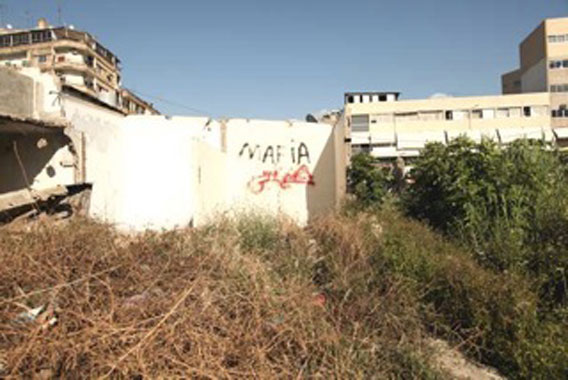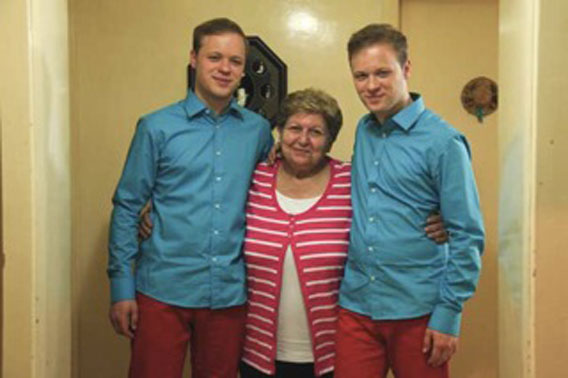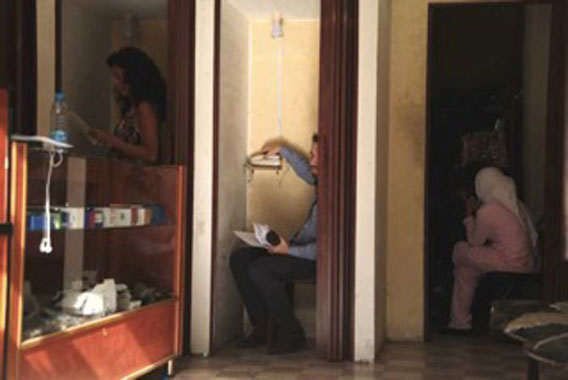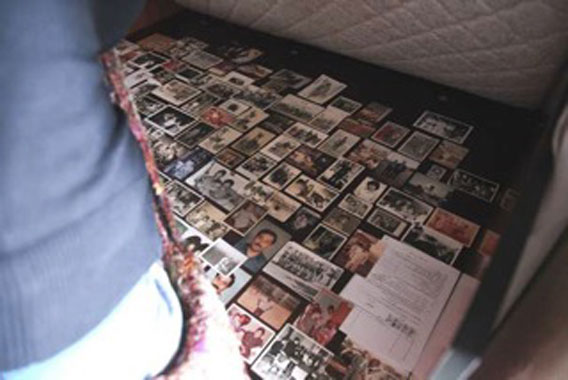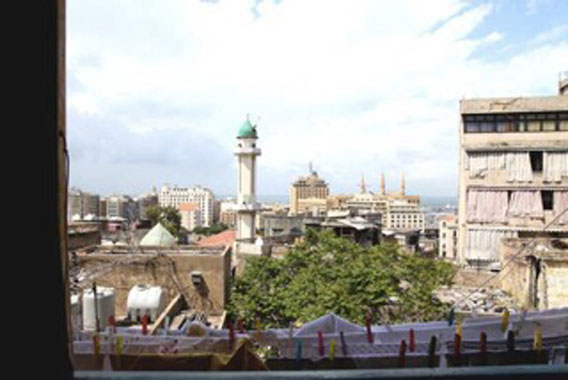Few cosmopolitan amblers will deny the desire to magically pass through one of the innumerable doorways that interrupt the smooth facade of city walls. The same can be said for the walls of the gallery. Art tourism can feel a little creepy, as if you were Edgar Allan Poe's "Man of the Crowd," haunted perhaps, but also anonymous and free to be a creature of urban design. Curators working in the MENA region take aim at such Orientalist fantasies of freedom in the European-controlled art market. But they don't all manage as successfully as curator of the Home Workspace Program 2012-13 at Ashkal Alwan Matthias Lilienthal's "X-Apartments" to discompose not only the easy transfer of the space of the gallery to any location, but the attendant comforts of the art patron.
Lilienthal's X-Apartments is a template for an art-making project that spans the gaps of art world/real world, artist/non-artist, performance/plastic art. It roughly takes the form of a self-guided tour of apartments in which the art is staged. This version took place in Beirut on May 12-15, 2013 in two distinct neighborhoods. The working class Orthodox Christian Armenian enclave of Bourj Hammoud, well east of downtown, is home to the largest population of Armenians outside of Armenia and attracts many tourists which its main street of jauntily-signed little shops seems built to accommodate. In contrast, Khandaq Al-Ghamiq is a heavily militarized Shiite community just south of the ever-encroaching empire of Solidere, Beirut’s controversial urban development project. Our starting point are well-known cafes proximate to each, Café Roundabout and Café Matador, respectively.
According to the materials provided by Lilienthal’s crew, art students must scope sites in neighborhoods, using local liaisons. Participants are paid $500US for the use of their apartments. Viewers are asked to sign-up for a specific time, split into groups of 2-3, and met at the sites, which they are asked to find for themselves, following copiously written detailed instructions that assist with the mazelike neighborhoods, traipsing through parking lots and alleyways, through courtyards and across fields of debris. Once we arrived at locations, met by docents, our viewing time was strictly controlled.
Lilienthal has staged X-Apartment performances numerous times in locations that could arguably fit into a template of postcolonial or developing post-communist urbanisms: Johannesburg, Istanbul, Sao Paulo, Warsaw, Caracas. And yet, this is intimately Beirut. With instructions such as: “go around the barbwire”; “You should have the bridge on your right and an office building on your left, then a wasteland”; “you see a mound of rubble and plants”; “pass an abandoned church and a row of arcaded abandoned buildings”; “walk until the barracks for the Lebanese army”; -- the quotidian chaos of Beirut’s fragmented urban environs that otherwise fade into normalization, where streets have no name and buildings have no addresses, is magically revived.
Camp Sanjak, Bourj Hammoud, Beirut
We wait by the graffiti that says “MAFIA” to be escorted to our first installation, which happens to be in the establishment of a family shoemaking business, R.M.P Accessoire, in the oldest refuge camp, Camp Sanjak, in Bourj Hammoud, a functioning ruin since the 1970s. Amidst the sheets of leather and construction supplies, we struggle with our role as consumers as art and shoes become interchangeable commodities. Should we buy a pair of shoes? The head shoemaker, Raffi Pamboukian, didn’t really seem to care. Is this an installation? Or is there one somewhere in here, apparently curated by the Academy of Media Arts Cologne (KHM)? We never really found out, We are asked by a purposely sketchy-seeming, chain-smoking anti-docent to enter a an upper room tricked out like a disco, drink alcohol, sway with the music, and finally like pose for fashion photos in rickety high fashion stilettos we are enjoined to select. Women, men, fashion-forward or sneaker-preferring -- no matter. Some male viewers we were told had flatly refused. Surely there's a politics to taste, to preferring abstract expressionism to realism, say. But what more direct or other form of politics was enacted in such refusal? That troubling sense of the undermining of art world subjectivities and judgment is one of the most provocative aspects of X-Apartments Beirut.
We amble to the next stop, repeating out loud the meticulously demanding directions. Bourj Hammoud is a neighborhood we had frequented regularly for dinners at Onno and Varouj, well known for authentic Armenian fare, but now the neighborhood was unpeeling in front of us. At Location 2, featuring the genius of Ale Bachlechner, Benjamin Ramírez Pérez, and Stefan Ramírez Pérez, we are sent to climb four flights of stairs to enter an apartment where we are first greeted and then asked to choose between two identical doors opening off the entryway by identically dressed, blond, blue-eyed twins.
Before you realize what's happening, you are split from your gallery-goer partner and ushered in to a living room (in one case) or boudoir (in the other) decorated in 1950s-era Middle Eastern kitsch. One of you it turns out is video-interviewed, efficiently and professionally, by a woman and man waiting just for this purpose. You answer rapid-fire questions about your character, your preferences in a partner and thoughts about family life. While in the other room the other twin sits you down in front of a TV, turns on the radio as you genteel-ly pass the time before he clicks on the TV. A Grandma, speaking in heavily accented English, questions an unseen suitor about their worthiness of her daughter's hand. A sudden cut to the suitor: it is your co-gallery goer, answering the questions in real-time as they are spliced to the pre-recorded prompts of the Grandma-as-match-maker. It's a surprising, amusing, and disturbing performance. Your friend is revealing herself -- or is it defending herself? -- unbeknownst. You recognize her self-proclamations: driven, mercurial, not really that into traditional family. But then you do a double take. You hear her describe herself as generous. Really? Do you buy her ideal self -- or do you find yourself resisting your friend's worthiness? Would you, along with Grandma, reject her? Again, before you can think it through, it's over. In the separation of your perception of the same person, your differences become open and secret at the same time, almost insanely dangerous. You meet again in the empty entryway, with so much to fill each other in on, to piece together. And yet, as you descend the dark stairwell together, you realize you can never say most of it, can no longer assume a unified or shared experience of art. Nor can this splitting of perception be easily transformed into a "positive" or enlightening experience. Somehow we both feel, as we are rushed out of the apartment to make way for the next viewers, that we have been unworthy of the civility and exacting requirements of Bourj Hammoud.
We turn again and again to the directions on the paper, eight times in total, clutching the sheets with determination, especially when lost. Some apartments feel less like an installation and more like a social event being hosted at a home of a local celebrity—we wonder if some of the art students lean too heavily, literalize the swap of life and art. Monira Al-Qadiri’s piece showcased a well-known Armenian actor with a living room full of his acting stills, welcoming us with arak and peanuts and stories about being a bodyguard for Shashi Kapoor. In another apartment (Jessica Khaazrik) we carefully make our way through the models of crafted wooden ships, homemade tools, dismantled gadgets, and other random tinkerings of the resident mechanical genius Oscar Guiragossian, owner of Maquettiste Minatures. Monica Restrepo provided a necessary respite at Fish Everyday, where our task as art viewers was merely to be fed delicious kibbe (deep fried bulgur and meat pies) with yogurt dressing; even the disjuncture between what the shop is known for and what we were provided to eat created pause. The finale in Bourj Hammoud is the Cinema Royale, a moldering and yet still functioning deco hulk, there we descended into the theater from a lobby plastered in colorful posters for mostly-forgotten films to chose seats furthest from the water dripping from the once-grand carven ceiling. The ruined grandeur strangely amplified the screening of carefully selected and spliced moments of homosexual gaze and panic in Egyptian film since the 1960s curated by Alex Baczynski-Jenkins.
While the scene for the four-hour tour in Bourj Hammoud is lively, jovial—we are forgiven our sins—Khandaq Al-Ghamiq, meaning deep trench or tunnel in Arabic, demands more intensive scrutiny of our presence as intruders. The neighborhood comprises a small, tightly-circumscribed warren of older buildings and some new construction on its edges. Having developed its reputation as a tunnel or passage for criminal economic networks, its integration into the city's economy remains troubled and since the end of the civil war the rebuilding of the abutting area of downtown has created an almost ostentatiously ghettoizing effect. The role of the inequalities of global citizen-mobility is specifically thematized in many, if not most, of the pieces. For instance, we are pressed to become members of the Occupation of Iraq (www.occupybaghdad.com) by virtue of our living outside Iraq and thinking we are not occupying it. This local Quran-bindery has been repurposed by Urok Shirhan into a bureaucratic performance of interrogation for the binding-in of cosmopolitans into a system of occupation and exploitation.
We are directed to X-Press Money, where Sri Lankan and Ethiopian migrant workers are wiring cash home and making international phone calls where we are ushered by Hicham Awad toward a bank of three phone booths. When was the last time either of us was in one of those? We are asked to wedge into one of these seeming relics from the 20th Century hidden in the back of a store devoted to more recent technologies of global cellular connectivity. Inside our separate booths, we each read a typewritten meditation on lost or impossible connection, while crackling noises, static, issue forth from the receiver. We strain to catch the message, but no we can’t hear anything but sound. In every relationship, connectivity or the co-creation of a narrative, only works until the connection itself -- those cables at the bottom of the sea, the transistors, headphones, cell towers, all the material that substrate of connectivity -- becomes all there is to hear and physics overwhelms the temporality of transmission.
Phone booths at X-press Money, Bourj Hammoud, Beirut
Some of the risk of being a gallery-goer is about confronting one's class aspirations so safely negotiated by showing up in the first place (you are obviously the type to go to galleries). Maybe you're not getting it at all, you're a fake! But there's always the possibility that your quiet discernment may be taken for your ability to afford to buy this art. This is the dirty deal of what it means to walk into the hushed antiseptic classed spaces of most galleries. But the economic architecture of X-Apartments Beirut reconstructs that dirty deal and leads to what we might call a post-postcolonial destabilization of risk exchange. X-Apartments demands of the spectator an extreme self-honesty and openness to art-as-experience. And the artists, the people of Beirut in their homes, are not suggesting that you can "get it" and become a discerning cosmopolitan or social do-gooder by taking in, by "buying" -- their art.
This is not to say that economic relations are not a part of this show. They are absolutely crucial and specific to Beirut as a city in constant embedded cyclings of ruin and development. There is a seamless refiguring of the museum gift shop, entrepreneurship-as-performance, and the ready-made as framed and packaged by the X-Apartment tours. This is not a circumnavigation of the problems of cultural and economic power on the one hand and the de-skilling of art training and the dilution of seriousness of art knowledge and even the distraction of attention on the part of gallery-goers (one needs down time, coffee breaks, snacks). Rather than tarry in these binaries, X-Apartments demands giving in to these pressures that can be a giving way into engagement with Beirut and with what art and art spectatorship can be.
The risk entailed in the X-Apartment tours is not relative, as in: I am now in a risky area of poverty or of strange people who want to do me harm. Rather, it is the process of being a viewer that is made risky in X-Apartments. You enter doorways without knowing what is on the other side, vastly different than entering or passing the doorway into a gallery space, or of allowing your eyes to open toward a work presented therein. These Beirut pieces detour and confront. In Khandaq Al Ghamiq we entered into a courtyard and right into the lens of a video camera on a tripod, with a mum camera operator behind it (curator Romain Hamard), following you as we acclimated to the space of the courtyard. We looked about us and noticed the videographer on the roof aiming a lens down at us; we now become objects of an ambush. We are ambushed by our own desire to see. Or for the exotic. We cannot deny our curiosity. Even in our own neighborhoods, we would be curious to be able to enter through the closed front doors lining the streets. Eventually a man emerges from behind a door and offers a performance of Arab hospitality (with real coffee service). We are sure we do not deserve the honor and can do nothing to repay it, except perhaps to attempt to commiserate about the strange Euro-space music that seems to be part of the piece. Gesticulating and smiling through the language barrier, you try to suggest that maybe something more lively, some dance music would be better for your host? He seems to appreciate the joke, though another man who has appeared and who speaks English and French is ignoring the space music atmosphere and arguing politics. Are you eavesdropping? Or are we the political subtext? We begin wondering when is the appropriate or polite time to take leave of this hospitality. Truth be told, we are desperate to leave. On the way back out -- we say goodbye as soon as we can drink down enough of the strong black coffee not to seem rude -- we encounter a middle-aged man wandering in immaculate, pressed pajamas. He is boiling with unspoken rage or madness. As we exit down the crumbling avenue away from the enclave, the man begins yelling, at whom or why we can never know. Nor can we purchase it or "appreciate" it. The upset reverberates.
Art that disturbs and that you want to escape is the most raw, unfiltered. It is uncapturable. It is the city itself. Here is an explanation of the way X-Apartments Beirut engaged this uneven architecture of precarity and beauty. In Khandaq al-Gamiq, the neighborhood is caught amid development, the former tunnel now wedged amid a new overpass, a walled ancient ruin site that cannot by law be "developed," and encroaching developing neighborhoods less historically mired in poverty (and less Islamic). In one apartment, artist Sara Hamde has designed a hunt of sorts, a mystery to solve. The clues are photos placed on the walls of various rooms. We are to move from locations following sounds from speakers placed around the apartment. The docent/ apartment dweller instructs us when we arrive in the cozy, centrally embedded bedroom, to find the hidden photos. We start poking around the carefully arrange items, embarrassed, opening closets and even sitting on the bed -- the room is almost completely taken up by the neatly made up platform bed -- turning over a pillow, he instructs you are getting warmer, further flustering and embarrassing us. We are failing to see -- the basic duty of a gallery-goer -- and the docent is disappointed in us and growing impatient. And we don't want to dig up or disturb this private place. But finally, in fear and under the gun so to speak, we lift up the mattress. Yes, people who don't trust the state keep their treasures under the mattress!
There it is, a collage of Polaroids in faded 1970s color. A man's life. He's holding a rifle, his hair is dark and wild, his eyes shining with strength and pride. Was this his apartment once? Him, celebrating, posing with family and children, at the beach, in restaurants. All the photos are faded and yet as alive as Beirutis' memories of their civil war. None of them match the decor of the room with its zebra-motif bedspread and department store knick-knacks and throw pillow. We lower the lid and the patient-impatient man leads us around the wall to the abutting balcony.
View from Khandaq al-Gamiq across downtown Beirut, the Mediterranean in the far distance
The view is magnificently, tightly layered out under the prevailing blue skies and sun of Lebanon. We can orient ourselves now, finally, after having been so focused on a trail, a hunt for the secret of Khandaq al-Gamiq. A mosque abuts a church, crescents and crosses, laundry lines criss-cross the density. Over the dwellings we see the expanse of the ancient ruin, and lining that the highway, on the other side of the highway the new downtown and the grand, imposing new Harriri mosque, the high rises and hotels. Khandaq al-Gamiq and this one long-held apartment and the people who lived and looked out here are a view-finder, the lens: this private view and the histories, inhabitations, and positions that attend and create it, which we are now offered a glimpse of and through, is fleeting, uncapturable. Not because it is not enduring, no. It's there right now -- the view is witnessing the development of Beirut under global capital and without proper care for its own histories still in place. It's still there.
Elena P. Glasberg is author of Antarctica As Cultural Critique: The Gendered Politics of Scientific Exploration and Climate Change (Palgrave 2012), the culmination of years of thinking outside American Studies. Glasberg teaches in the Writing Program at New York University.
Jasbir K. Puar is Associate Professor of Women’s & Gender Studies at Rutgers University. Puar is the author of Terrorist Assemblages: Homonationalism in Queer Times (Duke University Press 2007), which won the 2007 Cultural Studies Book Award from the Association for Asian American Studies. Puar’s forthcoming monograph, Affective Politics: States of Debility and Capacity (Duke University Press, 2014) takes up questions of disability in the context of theories of bodily assemblages that trouble intersectional identity frames. She is a 2013-14 Society for the Humanities Fellow at Cornell University, where she will be working on her third book, titled Inhumanist Occupation: Sex, Affect, and Palestine/Israel.

